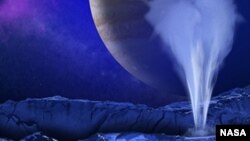NASA says it has spotted evidence of large water plumes shooting 200 kilometers over Jupiter’s moon Europa.
Using the Hubble Space Telescope, astronomers found water vapor above the moon’s south pole, which they say is likely from plumes of water shooting out of large ocean under Europa’s icy crust.
"By far the simplest explanation for this water vapor is that it erupted from plumes on the surface of Europa," said Lorenz Roth of Southwest Research Institute in San Antonio, Texas, lead author of a paper about the discovery.
He added that the discovery could make it easier to determine if life exists in the liquid ocean.
"If those plumes are connected with the subsurface water ocean we are confident exists under Europa's crust, then this means that future investigations can directly investigate the chemical makeup of Europa's potentially habitable environment without drilling through layers of ice," he said. "And that is tremendously exciting."
Evidence of water plumes was first spotted by Hubble a year ago using the imaging spectograph to detect a “telltale” “aural glow” created by water molecules being broken apart by electrons along magnetic field lines.
One reason for the plumes might be that large cracks along the icy surface are pushed and pulled by Jupiter’s gravity, allowing water to escape.
The Hubble team found that the intensity of Europa's plumes, like that Enceladus's plumes, varies with the moon's orbital position. Active jets have been seen only when Europa is farthest from Jupiter. But the researchers could not detect any sign of venting when Europa is closer to Jupiter.
The study appeared today’s online issue of Science Express, and was reported at the meeting of the American Geophysical Union in San Francisco.
Using the Hubble Space Telescope, astronomers found water vapor above the moon’s south pole, which they say is likely from plumes of water shooting out of large ocean under Europa’s icy crust.
"By far the simplest explanation for this water vapor is that it erupted from plumes on the surface of Europa," said Lorenz Roth of Southwest Research Institute in San Antonio, Texas, lead author of a paper about the discovery.
He added that the discovery could make it easier to determine if life exists in the liquid ocean.
"If those plumes are connected with the subsurface water ocean we are confident exists under Europa's crust, then this means that future investigations can directly investigate the chemical makeup of Europa's potentially habitable environment without drilling through layers of ice," he said. "And that is tremendously exciting."
Evidence of water plumes was first spotted by Hubble a year ago using the imaging spectograph to detect a “telltale” “aural glow” created by water molecules being broken apart by electrons along magnetic field lines.
One reason for the plumes might be that large cracks along the icy surface are pushed and pulled by Jupiter’s gravity, allowing water to escape.
The Hubble team found that the intensity of Europa's plumes, like that Enceladus's plumes, varies with the moon's orbital position. Active jets have been seen only when Europa is farthest from Jupiter. But the researchers could not detect any sign of venting when Europa is closer to Jupiter.
The study appeared today’s online issue of Science Express, and was reported at the meeting of the American Geophysical Union in San Francisco.









